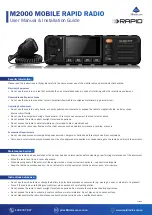
RLX-FHE, RLX-FHES, RLX-FHS
♦
RadioLinx FH
Ethernet Port Settings
Frequency-Hopping Industrial Radio
Page 102 of 151
ProSoft Technology, Inc.
November 25, 2008
6 Configure each individual radio in the network.
Configure all Remote/Repeater radios first, and then (last) configure the
Master radio.
7
When the network and all of its radios have been configured in the software,
physically label each radio, to eliminate any future confusion about which
hardware radios correspond with which radio configurations in the software.
Each label should identify:
o
The radio's "name" (the icon label in the software's graphical layout
screen), and whether it is a Master or Remote radio (if the name doesn't
indicate this).
o
IP Address
o
Subnet Mask
o
MAC ID
o
Network Channel
Continue the installation by
physically installing
antennas.
13.2 Ethernet
Addressing
Overview
Setting The IP Address of the Host Computer
Important: If you are unfamiliar with changing IP Addresses, contact your Network Administrator.
The IP address of the host computer that runs the setup software, needs to be
changed only if you are going to select an IP address for the radios that reside on
a different sub network (a network with a different network ID) than the sub
network currently configured.
For example, if the setup computer has an IP address of 207.4.1.3 in the TCP/IP
client network configuration and you want to program the IP address for the radio
to 192.168.15.1, then you will have to set up the host computer with an IP
address on the same network (for example, 192.168.15.10). This will allow you to
use the setup software to perform radio network diagnostics. (See section 4.1 on
performing network diagnostics).
IP addresses are in the following format: www.xxx.yyy.zzz - called 'dot format'
Classes of IP addresses are determined by value of the first 'octet' (the 'www').
The classes are as follows:
Class
First Octet Value Network Identifier
Device Identifier
Subnet Mask
A
1 to 126
'w.' values
'x.y.z' values
'255.0.0.0'
B
128 to 191
'w.x' values
'x.y' values
'255.255.0.0'
C
192 to 223
'w.x.y' values
'x' values
'255.255.255.0'
The Subnet Mask is used to distinguish the Network ID and the Device ID.
For Example:
An IP address of 192.168.15.4 is on the Network 192.168.15; and the Device ID
is 4.
An IP address of 10.120.22.75 is on the Network 10 and the Device ID
is120.22.75.
Summary of Contents for RadioLinx FH Series
Page 6: ......
















































